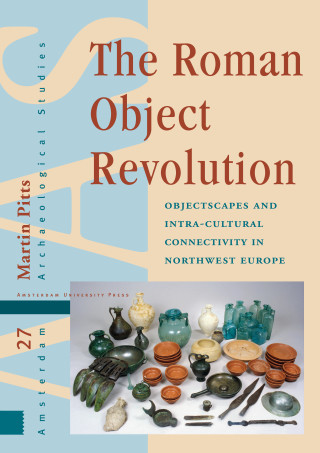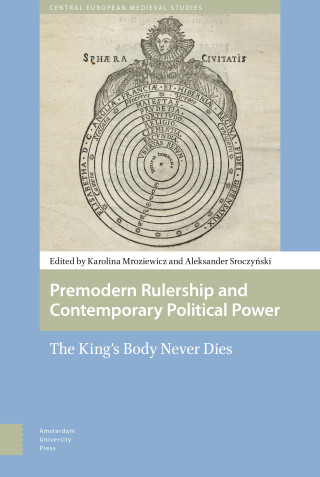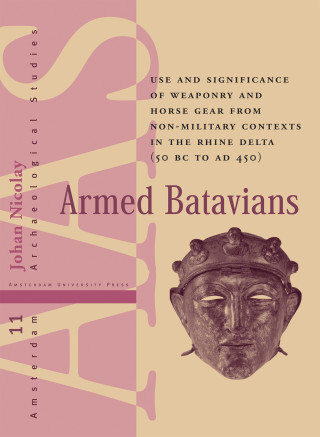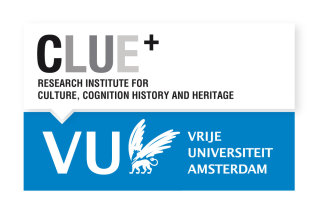
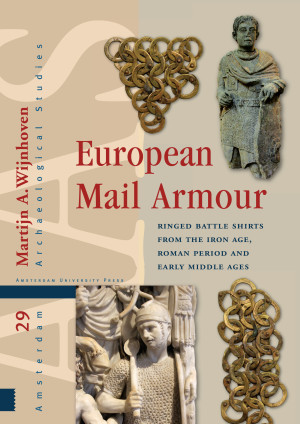
- Title
- European Mail Armour
- Subtitle
- Ringed Battle Shirts from the Iron Age, Roman Period and Early Middle Ages
- Author
- Martijn A. Wijnhoven
- Price
- € 188,00 excl. VAT
- ISBN
- 9789463721264
- Format
- Hardback
- Number of pages
- 520
- Language
- English
- Publication date
- 23 - 12 - 2021
- Dimensions
- 21 x 29.7 cm
- Partner

- Discipline
- History, Art History, and Archaeology
- Preview
- Download Preview
- Also available as
- eBook PDF - € 187,99
Contents
Acknowledgements
1 Introduction
1.1 Previous research
1.2 Research question and aims
1.3 Chaîne opératoire
1.4 A multi-dimensional approach to material studies
1.5 Scope
1.6 Mail or chain-mail?
2 The Origins of Mail Armour
2.1 Suggested precursors
2.2 Contested origins
2.3 Earliest evidence
2.4 Tracing the earliest contexts
2.5 Further dispersal
2.6 When, where and by whom
3 Distribution and Archaeological Contexts
3.1 Battlefields and accidental loss
3.2 Iron Age mail
3.3 The Roman Republic
3.4 The Roman Principate
3.5 Hybrid feathered armour
3.6 Hybrid armour beyond the roman empire
3.7 Late Antiquity
3.8 The Barbaricum and beyond
3.9 Mail for men, women and children
3.10 Social access to mail outside the Roman Empire
3.11 Centuries of archaeological evidence
4 The Iconography of Early Mail Armour
4.1 the iconographic evidence
4.2 the 3rd century bc to the end of the roman republic
4.3 early empire until the end of the 1st century ad
4.4 the 2nd century ad
4.5 the 3rd to 5th century ad
4.6 development of mail armour design in iconography
5 The Naming of Mail Armour
5.1 Classical literature on armour
5.2 Lorica hamata
5.3 Other designations
5.4 Simply lorica
6 Decoration in Mail Garments
6.1 Gold on silver
6.2 Copper alloy elements
6.3 Decorative origin
6.4 Development and distribution
6.5 Decorative trimmings
6.6 Inserted patterns
6.7 Contrasting rivets
6.8 Decoration of hybrid armour
6.9 Decoration of ‘miniature mail’
6.10 Decorative hems
6.11 Colourful Roman army
7 Padded Garments
7.1 the advantages and disadvantages of flexible armour
7.2 himation, thoracomachus, subarmalis and cimmerian tunic
7.3 textile and leather remains
7.4 medieval analogy, gladiators and pteruges
7.5 concealed by metal armour
8 The Craft of Making Mail Rings
8.1 The mail maker’s process
8.2 The manufacture of metal wire
8.3 The manufacture of solid rings
8.4 Unravelling the use of butted rings
8.5 Loose rings
8.6 The mail making workshop
9 Weaving Patterns
9.1 Four-in-one pattern
9.2 Six-in-one pattern from tiefenau
9.3 Pinched loop-in-loop pattern from Bertoldsheim
9.4 Four-in-one pattern in hybrid armour
9.5 Favourable characteristics
10 The Construction of Mail Garments
10.1 Current knowledge based on late mail from Europe
10.2 Presence of constructional techniques in early mail
10.3 Construction of early mail by working in the flat
10.4 Construction of textile clothing and mail
10.5 Construction of the coat with shoulder guards
10.6 Mail with shoulder guards and textile clothing
10.7 The development of mail armour through the ages
10.8 Construction in cultural context
11 Ring Characteristics
11.1 The relevance of the seemingly irrelevant
11.2 Ring size
11.3 Direction of the overlap and ring types
11.4 Cross-section of riveted rings
11.5 Rivet characteristics
11.6 Shape of the overlap in riveted rings
11.7 Cross-section of solid rings
11.8 Ring characteristics typology
12 Final Considerations
12.1 Insights
12.2 Prospects
12.3 Methodological potential
Bibliography
Database
Appendix 1. Catalogue of mail armour
Appendix 2. Catalogue of hybrid armour
Appendix 3. Catalogue of isolated finds of fasteners and fixtures
Appendix 4. Finds excluded from the database
Acknowledgements
1 Introduction
1.1 Previous research
1.2 Research question and aims
1.3 Chaîne opératoire
1.4 A multi-dimensional approach to material studies
1.5 Scope
1.6 Mail or chain-mail?
2 The Origins of Mail Armour
2.1 Suggested precursors
2.2 Contested origins
2.3 Earliest evidence
2.4 Tracing the earliest contexts
2.5 Further dispersal
2.6 When, where and by whom
3 Distribution and Archaeological Contexts
3.1 Battlefields and accidental loss
3.2 Iron Age mail
3.3 The Roman Republic
3.4 The Roman Principate
3.5 Hybrid feathered armour
3.6 Hybrid armour beyond the roman empire
3.7 Late Antiquity
3.8 The Barbaricum and beyond
3.9 Mail for men, women and children
3.10 Social access to mail outside the Roman Empire
3.11 Centuries of archaeological evidence
4 The Iconography of Early Mail Armour
4.1 the iconographic evidence
4.2 the 3rd century bc to the end of the roman republic
4.3 early empire until the end of the 1st century ad
4.4 the 2nd century ad
4.5 the 3rd to 5th century ad
4.6 development of mail armour design in iconography
5 The Naming of Mail Armour
5.1 Classical literature on armour
5.2 Lorica hamata
5.3 Other designations
5.4 Simply lorica
6 Decoration in Mail Garments
6.1 Gold on silver
6.2 Copper alloy elements
6.3 Decorative origin
6.4 Development and distribution
6.5 Decorative trimmings
6.6 Inserted patterns
6.7 Contrasting rivets
6.8 Decoration of hybrid armour
6.9 Decoration of ‘miniature mail’
6.10 Decorative hems
6.11 Colourful Roman army
7 Padded Garments
7.1 the advantages and disadvantages of flexible armour
7.2 himation, thoracomachus, subarmalis and cimmerian tunic
7.3 textile and leather remains
7.4 medieval analogy, gladiators and pteruges
7.5 concealed by metal armour
8 The Craft of Making Mail Rings
8.1 The mail maker’s process
8.2 The manufacture of metal wire
8.3 The manufacture of solid rings
8.4 Unravelling the use of butted rings
8.5 Loose rings
8.6 The mail making workshop
9 Weaving Patterns
9.1 Four-in-one pattern
9.2 Six-in-one pattern from tiefenau
9.3 Pinched loop-in-loop pattern from Bertoldsheim
9.4 Four-in-one pattern in hybrid armour
9.5 Favourable characteristics
10 The Construction of Mail Garments
10.1 Current knowledge based on late mail from Europe
10.2 Presence of constructional techniques in early mail
10.3 Construction of early mail by working in the flat
10.4 Construction of textile clothing and mail
10.5 Construction of the coat with shoulder guards
10.6 Mail with shoulder guards and textile clothing
10.7 The development of mail armour through the ages
10.8 Construction in cultural context
11 Ring Characteristics
11.1 The relevance of the seemingly irrelevant
11.2 Ring size
11.3 Direction of the overlap and ring types
11.4 Cross-section of riveted rings
11.5 Rivet characteristics
11.6 Shape of the overlap in riveted rings
11.7 Cross-section of solid rings
11.8 Ring characteristics typology
12 Final Considerations
12.1 Insights
12.2 Prospects
12.3 Methodological potential
Bibliography
Database
Appendix 1. Catalogue of mail armour
Appendix 2. Catalogue of hybrid armour
Appendix 3. Catalogue of isolated finds of fasteners and fixtures
Appendix 4. Finds excluded from the database
Reviews and Features
This full-colour book features over 300 images!
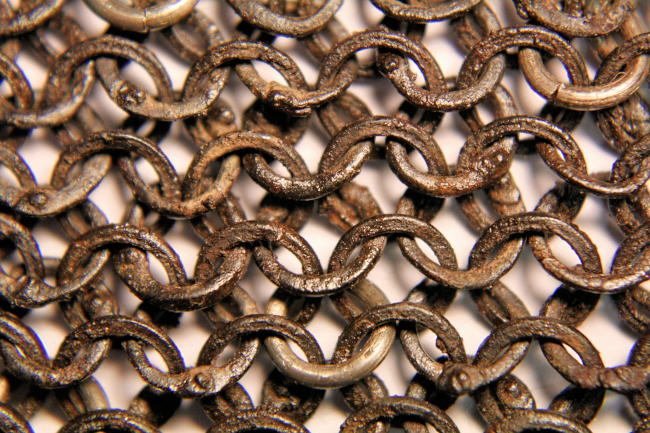 Carlingwark Loch, photo by Martijn A. Wijnhoven ©.
Carlingwark Loch, photo by Martijn A. Wijnhoven ©.
"Mail has been something of a Cinderella in the field of early martial equipment. Now, in this meticulous study, Wijnhoven has demonstrated and explored the extensive potential of the archaeological, iconographic and textual evidence. It makes a fundamental contribution to the study of ancient martial material culture, and has broader implications for the development and structuring of early European ironworking traditions."
- Prof. Simon James, University of Leicester
"Mail armour has been largely neglected by specialist literature, despite the important role that it played in Antiquity. This book fills in that research gap in an impressive manner. Not only does Wijnhoven pose the hardest questions about mail armour, but he also provides very satisfactory answers."
- Prof. Thomas Fischer, Universität zu Köln
"This excellent monograph provides a thorough and multifaceted exploration of mail in Europe from its development in the Late Iron Age into the Early Middle Ages, roughly 300 BCE to 1000 CE.[...]The production values are superb, replete with numerous high-resolution photographs and illustrations in colour, offering a close-up look at mail scattered across international collections and not always on active display. This definitive book will prove a cornerstone for pre-modern armour studies for decades to come."
- Michael J. Taylor, The Classical Review (2022)
"This volume is probably destined to be the ‘go-to’ standard work for European ring-mail armour. It is intelligently assembled and supported by much gathered evidence.[...]This is a superb piece of research, presented in an easily understood format, containing much useful information. I recommend it unhesitatingly to anyone who has an interest in ancient ring mail armour."
- Dr. Michael Thomas, Ancient Warfare Magazine, Vol. XV, Iss. 4
“Martijn Wijnhoven’s book is a thoughtful and comprehensive investigation, long required, into early European mail armour. […] The book is well illustrated, supporting the overview of the technical details. This study traces a success story of an Iron Age technology that remained an important piece of defensive armour until the nineteenth century AD, with only minor modifications. If you want to know anything, or rather everything, about early mail armour, you need look no further!”
- Marion Uckelmann, “New Book Chronicle,” Antiquity, 2023, Vol. 97
- Prof. Simon James, University of Leicester
"Mail armour has been largely neglected by specialist literature, despite the important role that it played in Antiquity. This book fills in that research gap in an impressive manner. Not only does Wijnhoven pose the hardest questions about mail armour, but he also provides very satisfactory answers."
- Prof. Thomas Fischer, Universität zu Köln
"This excellent monograph provides a thorough and multifaceted exploration of mail in Europe from its development in the Late Iron Age into the Early Middle Ages, roughly 300 BCE to 1000 CE.[...]The production values are superb, replete with numerous high-resolution photographs and illustrations in colour, offering a close-up look at mail scattered across international collections and not always on active display. This definitive book will prove a cornerstone for pre-modern armour studies for decades to come."
- Michael J. Taylor, The Classical Review (2022)
"This volume is probably destined to be the ‘go-to’ standard work for European ring-mail armour. It is intelligently assembled and supported by much gathered evidence.[...]This is a superb piece of research, presented in an easily understood format, containing much useful information. I recommend it unhesitatingly to anyone who has an interest in ancient ring mail armour."
- Dr. Michael Thomas, Ancient Warfare Magazine, Vol. XV, Iss. 4
“Martijn Wijnhoven’s book is a thoughtful and comprehensive investigation, long required, into early European mail armour. […] The book is well illustrated, supporting the overview of the technical details. This study traces a success story of an Iron Age technology that remained an important piece of defensive armour until the nineteenth century AD, with only minor modifications. If you want to know anything, or rather everything, about early mail armour, you need look no further!”
- Marion Uckelmann, “New Book Chronicle,” Antiquity, 2023, Vol. 97
Martijn A. Wijnhoven
European Mail Armour
Ringed Battle Shirts from the Iron Age, Roman Period and Early Middle Ages
Mail armour (commonly mislabelled 'chainmail') was used for more than two millennia on the battlefield. After its invention in the Iron Age, mail rapidly spread all over Europe and beyond. The Roman army, keen on new military technology, soon adopted mail armour and used it successfully for centuries. Its history did not stop there and mail played a vital role in warfare during the Middle Ages up to the Early Modern Period.
Given its long history, one would think mail is a well-documented material, but that is not the case. For the first time, this books lays a solid foundation for the understanding of mail armour and its context through time. It applies a long-term multi-dimensional approach to extract a wealth of as yet untapped information from archaeological, iconographic and written sources. This is complemented with technical insights on the mail maker’s chaîne opératoire.
Given its long history, one would think mail is a well-documented material, but that is not the case. For the first time, this books lays a solid foundation for the understanding of mail armour and its context through time. It applies a long-term multi-dimensional approach to extract a wealth of as yet untapped information from archaeological, iconographic and written sources. This is complemented with technical insights on the mail maker’s chaîne opératoire.
Author
Martijn A. Wijnhoven
Martijn A. Wijnhoven holds a PhD in archaeology from Vrije Universiteit Amsterdam. He specializes in ancient military studies and has published extensively on the analysis and reconstruction of ancient armour spanning from the Iron Age to the Middle Ages. His research combines methods from history, anthropology, and archaeology, rendering a holistic approach to material studies.

